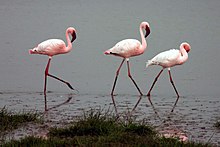Lesser flamingo
| Lesser flamingo | |
|---|---|
 |
|
| At Ngorongoro Crater, Tanzania | |
| Scientific classification | |
| Kingdom: | Animalia |
| Phylum: | Chordata |
| Class: | Aves |
| Order: | Phoenicopteriformes |
| Family: | Phoenicopteridae |
| Genus: |
Phoeniconaias G.R. Gray, 1869 |
| Species: | P. minor |
| Binomial name | |
|
Phoeniconaias minor Geoffroy Saint-Hilaire, 1798 |
|
The lesser flamingo (Phoeniconaias minor) is a species of flamingo occurring in sub-Saharan Africa with another population in India. Birds are occasionally reported from further north, but these are generally considered vagrants. Until 2014, it was classified in genus Phoenicopterus but is now classified as the only species in the genus Phoeniconaias, the only monotypic genus of flamingo.
The lesser flamingo is the smallest species of flamingo, though it is a tall and large bird by most standards. The species can weigh from 1.2 to 2.7 kg (2.6 to 6.0 lb). The standing height is around 80 to 90 cm (31 to 35 in). The total length (from beak to tail) and wingspan are in the same range of measurements, from 90 to 105 cm (35 to 41 in). Most of the plumage is pinkish white. The clearest difference between this species and the greater flamingo, the only other Old World species of flamingo, is the much more extensive black on the bill. Size is less helpful unless the species are together, since the sexes of each species also differ in height.
The lesser flamingo may be the most numerous species of flamingo, with a population that (at its peak) probably numbers up to two million individual birds. This species feeds primarily on Spirulina, algae which grow only in very alkaline lakes. Presence of flamingo herds near water bodies is indication of sodic alkaline water which is not suitable for irrigation use. Although blue-green in colour, the algae contain the photosynthetic pigments that give the birds their pink colour. Their deep bill is specialised for filtering tiny food items. The lesser flamingo also feeds on shrimp.
Lesser flamingos are prey to a variety of species, including marabou storks, baboons, African fish eagles, wildcats, and African golden wolves.
...
Wikipedia

